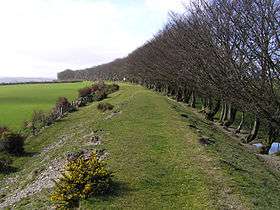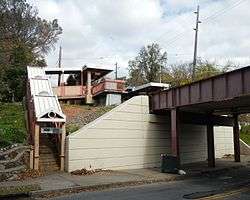Embankment (earthworks)
A road, railway line or canal is normally raised onto an embankment made of compacted soil (typically clay or rock-based) to avoid a change in level required by the terrain, the alternatives being either to have an unacceptable change in level or detour to follow a contour. A cutting is used for the same purpose where the land is originally higher than required.
.png)


Materials
Embankments are often constructed using material obtained from a cutting. Embankments need to be constructed using non-aerated and waterproofed, compacted (or entirely non-porous) material to provide adequate support to the formation and a long-term level surface with stability.
Intersection of embankments
To intersect an embankment without a high flyover, a series of tunnels can consist of a section of high tensile strength viaduct (typically built of brick and/or metal) or pair of facing abutments for a bridge.
Notable embankments
- Burnley Embankment: The largest canal embankment in Britain.
- Harsimus Stem Embankment: The remains of a railway built by the Pennsylvania Railroad in Jersey City, New Jersey, United States
- Stanley Embankment: A railway, road and cycleway that connects the Island of Anglesey and Holy Island, Wales. It carries the North Wales Coast Line and the A5 road.
See also
- Causeway
- Cut and fill
- Cut (earthmoving)
- Fill dirt
- Grade (slope)
- Land reclamation
- Levee
- Roadbed
- Track bed
References
External links
- Federal Highway Administration Design Manual: Deep Mixing for Embankment and Foundation Support Federal Highway Administration
bibliography
- Scott, J., Loveridge, F., & O'Brien, A. S. (2007). of climate and vegetation on railway embankments.